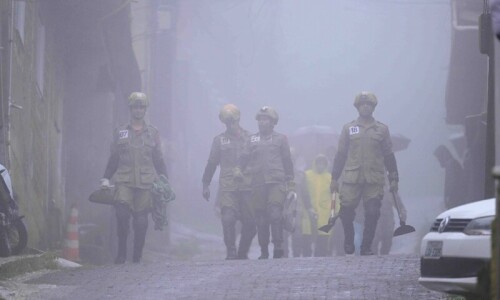Authorities in southern Brazil raced against the clock on Sunday to rescue people from raging floods and mudslides that have killed at least 66 and forced more than 80,000 to flee their homes.
Across Porto Alegre, the capital city of Rio Grande do Sul state, people stood on rooftops hoping to be rescued, while others in canoes or small boats navigated streets that had turned into rivers.
Civil defence officials said at least 101 people were missing in the latest in a string of catastrophic weather events in the South American giant.
Viewed from the air, Porto Alegre was completely flooded, with streets under water and the roofs of some houses barely visible.
According to the local municipality, the Guaiba River, which flows through the city of 1.4 million people, reached a record high level of 5.3 metres, well above the historic peak of 4.76 metres that had stood as a record since the devastating 1941 floods.
Water was still advancing into economically important Porto Alegre and hundreds of other localities, with increasingly dramatic consequences. Rain was intermittent on Sunday morning, but was expected to continue for another day at least as floodwaters kept rising.
In addition to the tens of thousands forced from their homes, Brazil’s civil defence agency said more than a million people lacked access to drinking water and it described the damage as incalculable. Some 15,000 people are now living in shelters.
Rosana Custodio, a 37-year-old nurse, fled her flooded Porto Alegre home with her husband and three children.
“During the night on Thursday the waters began to rise very quickly,” she told AFP via a WhatsApp message. “In a hurry, we went out to look for a safer place. But we couldn’t walk … My husband put our two little ones in a kayak and rowed with a bamboo. My son and I swam to the end of the street,” she said.
Her family was safe but “we’ve lost everything we had.”
“It’s terrifying”
Authorities scrambled to evacuate swamped neighbourhoods as rescue workers used four-wheel-drive vehicles — and even jet skis — to manoeuvre through waist-deep water in search of the stranded.
Rio Grande do Sul Governor Eduardo Leite said his state, normally one of Brazil’s most prosperous, would need a “Marshall Plan” of heavy investment to rebuild.
Sunday will be a key day for the rescue effort, said Paulo Pimenta, a senior communications official under President Luiz Inacio Lula da Silva.
Long lines formed as people tried to board buses in many places, although bus services to and from the city centre were cancelled. Porto Alegre International Airport suspended all flights on Friday for an undetermined period.
Lula posted a video of a helicopter depositing a soldier atop a house, who then used a brick to pound a hole in the roof and rescue a baby wrapped in a blanket. The speed of the rising waters unnerved many.
“It’s terrifying because we saw the water rise in an absurd way, it rose at a very high speed,” said Greta Bittencourt, a 32-year-old professional poker player.
“Unprecedented”
Leite, the governor, said in a live transmission on Instagram the situation in the state, which is home to agroindustrial production of soy, rice, wheat and corn, was “absolutely unprecedented” and the worst in the state’s history.
Residential areas were underwater as far as the eye could see, with roads destroyed and bridges swept away by powerful currents. Rescuers faced a colossal task, with entire towns inaccessible.
Local officials have said that at least 300 municipalities have suffered storm damage in Rio Grande do Sul since Monday.
‘Disastrous cocktail’
The rains also affected the southern state of Santa Catarina. Lula, who visited the region on Thursday, blamed the disaster on climate change.
The devastating storms were caused by a “disastrous cocktail” of global warming and the El Nino weather phenomenon, climatologist Francisco Eliseu Aquino told AFP on Friday.
South America’s largest country has recently experienced a string of extreme weather events, including a cyclone in September that killed at least 31 people.
















































Dear visitor, the comments section is undergoing an overhaul and will return soon.